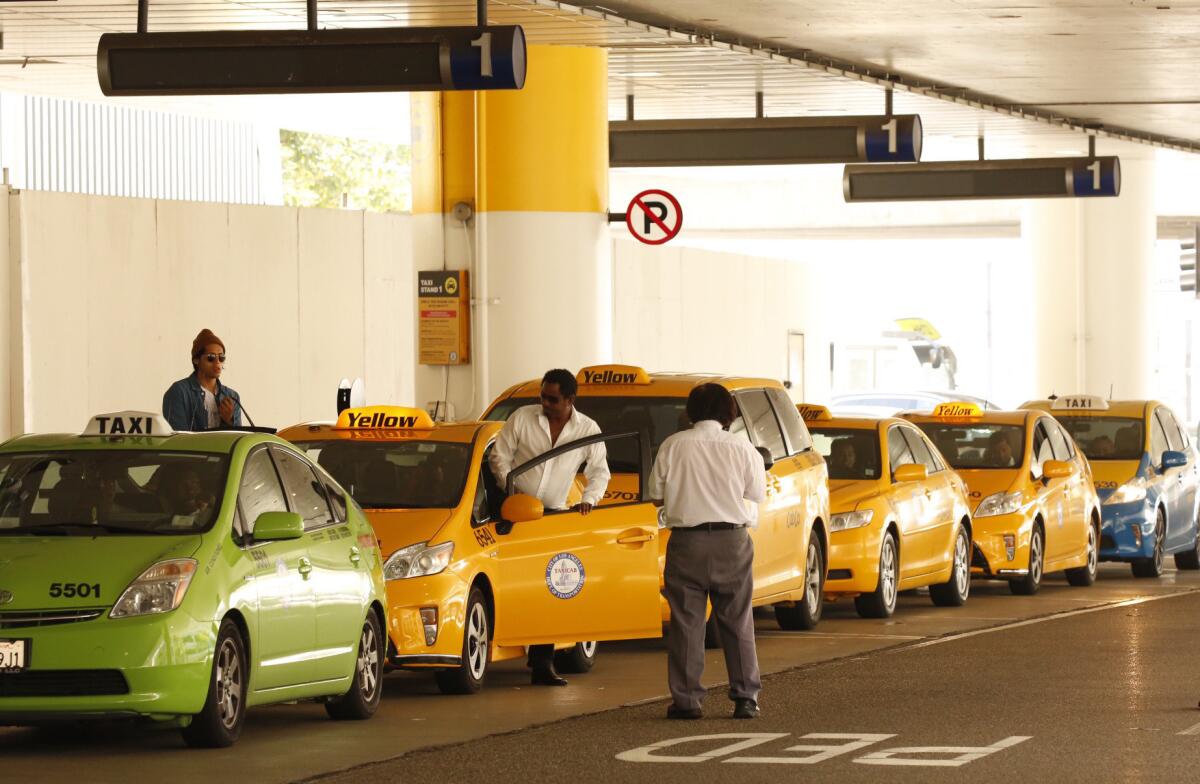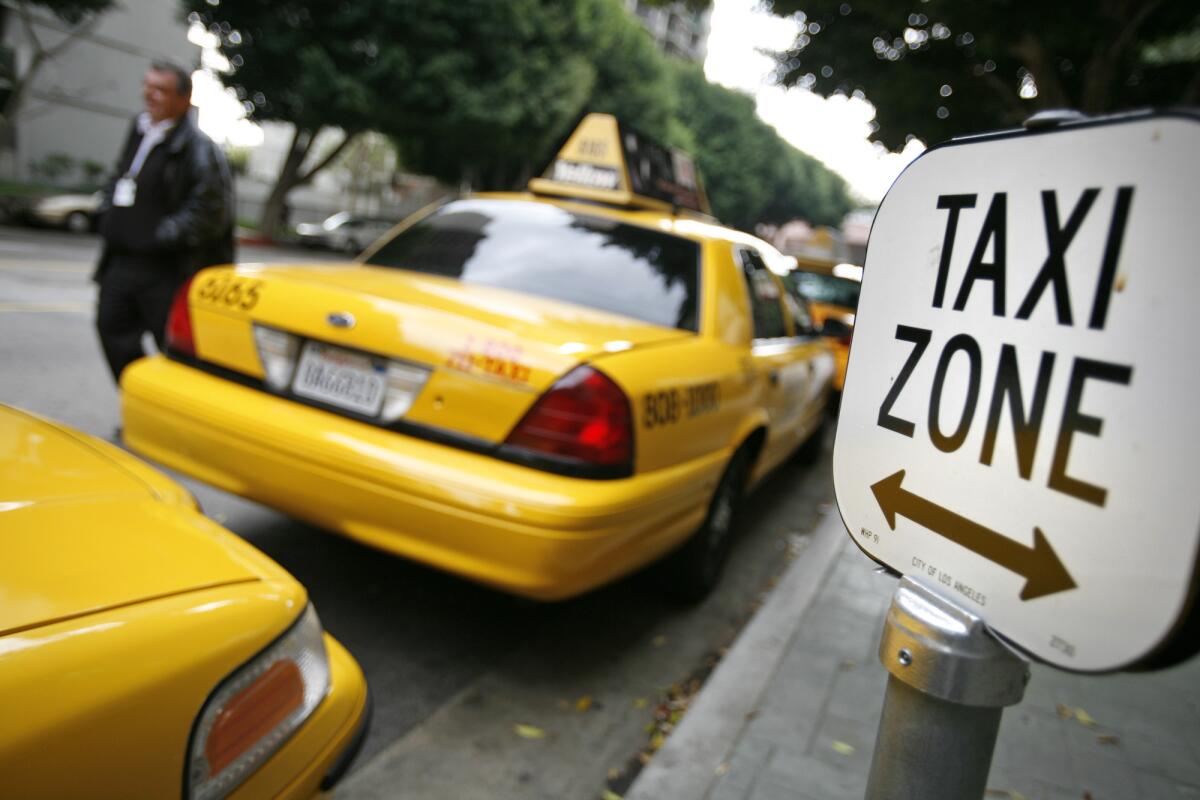Uber and Lyft have devastated L.A.’s taxi industry, city records show

Taxis wait in line at LAX Terminal One on Thursday.
- Share via
The rise of Uber and Lyft has dealt a swift, brutal blow to the Los Angeles taxi industry.
Since the ride-hailing services began operating in Southern California three years ago, the number of L.A. taxi trips arranged in advance has fallen by 42%, according to city records, and the total number of trips has plummeted by nearly 30%.
The steepest drops were in the city’s most popular nightlife and tourist destinations: the Westside, Hollywood and downtown.
The declines point to a dramatic shift wrought by the popular app-based transportation companies, which have wrested market share from taxi companies that have enjoyed decades of dominance in Los Angeles. The decline mirrors what’s happening across the country, as taxis — regulated by local governments on everything from price to the color of their cars — struggle to compete with cheaper, more nimble start-ups.
In San Francisco, the corporate home of both Uber and Lyft, the number of trips taken per taxi dropped by more than two-thirds over a two-year period. Drivers in Boston, Washington and New York City have reported less dramatic declines.
In Los Angeles, the brunt of the downturn has fallen on the drivers, many of whom sit behind the wheel full time, said taxi commission President Eric Spiegelman. By contrast, Uber and Lyft representatives say most of their drivers work part time to supplement income from other jobs.
Although numbers can vary dramatically depending on where and how often drivers work, the typical taxi driver has traditionally taken home about $40,000 a year after taxes and fees, said Jeannine Brands, a city engineering associate who specializes in taxi data.
Like their start-up competitors, taxi drivers in L.A. are independent contractors, but they pay to rent their vehicles and dispatch systems from the city’s nine licensed companies. Those rental fees have remained steady, even when the number of trips they’re making has dropped.
“The drivers are taking a hit, a big hit, and it’s really painful,” Spiegelman said.
Paul Ezadjian, 56, a manager for LA Checker Cab, said many drivers have seen their trips fall by as much as 40%, and the decline seems to be accelerating.

Taxis line up in front of the Omni Hotel in downtown Los Angeles, an area where drivers have lost much of their business to ride-hailing services.
After insurance premiums, gas and payments to lease their cabs, taxi drivers now take home $400 to $500 per week, down from $800 a few years ago, Ezadjian said.
Some have even left to drive for Uber, he said, lured by the company’s popularity and its lower overhead costs, including no vehicle leasing fees. Still, Uber’s per-mile rate is lower than that of taxis, which have their rates set by city officials. Uber also takes 20% of every fare.
With those rates, driving less than 200 miles per day makes it impossible to make a full-time living, Ezadjian said. “For a consumer, Uber is very good,” he said. “But for the driver, it’s very bad.”
That’s apparent from the number of drivers who’ve received permits to work in Los Angeles. After years of slow but steady increases, the city has shed 586 drivers over the last three years — a decline of 14%, the data show.
Taxi drivers have long flocked to dense districts in central Los Angeles and on the Westside for a steady stream of fares. Trips in those areas requested by phone and online have typically represented three-fourths of the city’s prearranged rides.
Over a three-year period, though, the number of trips in Hollywood and downtown Los Angeles fell 44%, while trips on the Westside decreased by more than half.
The one exception is in South L.A., where drivers are making 6% more prearranged trips than they were three years ago.
After decades of taxi drivers refusing to serve neighborhoods south of the 10 Freeway, a practice called redlining, Los Angeles officials passed regulations that require companies to complete a set percentage of requested trips in every area of the city.
Even after those regulations, though, a higher percentage of taxi trips in South L.A. were never completed, either because drivers never arrived or because customers requested two or three taxis, assuming only one would come.
Some drivers perceived the area as dangerous, Brands said. Others were reluctant to make short trips — to the grocery store, or the doctor — rather than going to Hollywood or Los Angeles International Airport.
But since Uber and Lyft arrived in the area, more people who request rides are getting them.
“Now that there’s so much competition in the most lucrative neighborhoods, drivers are serving areas that they hadn’t served as well,” Spiegelman said.
“It helps compensate for their revenue loss.”
He added: “This is not a zero-sum game. There are many ways in which this situation has not been an improvement, but there are some ways in which it has.”
The silver lining in the data is LAX, which has long been the stronghold of the Southern California taxi industry because trips that begin there are typically longer and more lucrative.
Since Uber and Lyft arrived, taxis have increased their trips at the airport by 41%. That increase has helped offset the revenue loss from the decline in other types of business.
What’s unclear is whether taxis will be able to maintain their market share at LAX now that Uber and Lyft can pick up passengers there too.
After a protracted fight at City Hall, officials gave both companies the green light to send their drivers there several months ago. Preliminary data suggest Uber and Lyft drivers are picking up about 24,000 rides per week.
Still, Spiegelman said, it’s possible that enough travelers need to get out of LAX that there’s market enough for cabbies and ride-hail drivers.
And, he said, there’s another bright spot: No taxi companies have gone out of business.
For more transportation news, follow @laura_nelson on Twitter.
ALSO
How a state senator -- whose family is in the taxi business -- put the brakes on two Uber bills
Lyft defies predictions by continuing to grow as a rival to Uber
GM helps Lyft raise $1 billion, and they plan a network of self-driving cars
More to Read
Sign up for Essential California
The most important California stories and recommendations in your inbox every morning.
You may occasionally receive promotional content from the Los Angeles Times.










